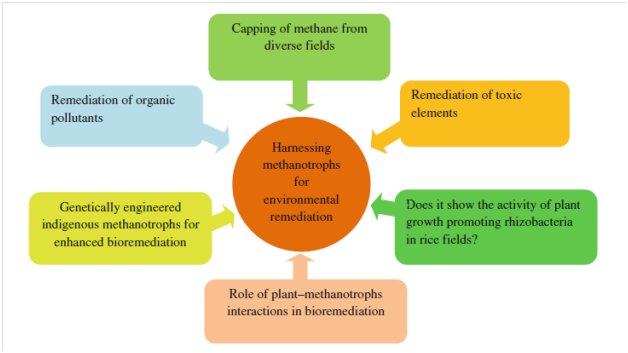Authors: Lal Chand Malav, Shakeel A. Khan, Sandeep Kumar, Mahesh Kumar Malav
Global warming is the burning issue worldwide now. Methane (CH4) is one of the greenhouse gases (GHGs), which contributes to global warming. Methane is about 25 times more effective as a greenhouse gas than carbon dioxide (CO2). Methanotrophs are the only known significant biological sink for atmospheric CH4 and play a crucial role in reducing CH4 load up to 15 % to the total global CH4 destruction (Singh et al. 2010).
Broad-spectrum methane oxidizing methane monooxygenase (MMO) enzyme is found only in methanotrophs, which possess two forms, namely membrane-associated or particulate form (pMMO) and soluble or cytoplasmic form (sMMO). The pMMO is found in all known methanotrophs except for the genus Methylocella (acidophilic) (Theisen et al. 2005), while the sMMO is present only in a few methanotroph strains (Murrell et al. 2000). There are several sources that generate huge amount of toxic heavy metals/metalloids (Cr, Cd, Pb, As, Cu, Zn, Ni, Hg, etc.) and organic pollutants into the environment (Wijnhoven et al. 2007). Soils contaminated with heavy metals and/or organic pollutants are generally left abandoned for several years and therefore may not be safe for agricultural production.
Remediation of hazardous organic pollutants by methanotrophs-
Methanotrophs synthesize both particulate and soluble forms of methane monooxygenases (pMMO and sMMO, respectively), which can co-metabolize diverse type of hydrocarbons and halogenated organic compounds including aromatics.
Remediation of heavy metals by methanotrophs-
Methanotrophs also influence the speciation and bioavailability of metals in the environment. Eg. Reductive transformation of soluble and more toxic Cr(VI) into a less toxic Cr(III)species by methanotrophic bacteria (Methylococcus capsulatus Bath), as the Cr(III) is insoluble and tends to get precipitated at high pH.
Table: Methanotrophic bacteria involved in the bioremediation of various toxic hydrocarbon and heavy metal pollutants
| Methanotrophic species | Targeted organic pollutants |
| Methylosinus trichosporium OB3b | Halogenated hydrocarbons |
| Methylomonas albus BG8, Methylocystis parvus OBBP, and Methylosinus trichosporium OB3b | Polynuclear aromatic hydrocarbons and transition metals |
| Methylosinus trichosporium OB3b | TCE |
| Type II methanotrophs | Phenanthrene, anthracene, and fluorine |
| Methylocystis sp. M, Methylococcus capsulatus (Bath), Methylosinus trichosporium OB3b, Methylosinus sporium strain 5, and unidentified strains of methanotrophs (MP18, MP20, P14) | TCE-degradation |
| Type II methanotrophs | TCE |
| Methylosinus trichosporium OB3b and Methylocystis daltona SB2 | TCE, DCE, and VC |
| Methylocystis strain SB2 | Vinyl chloride (VC), dichloroethylene (DCE), Trichloroethylene (TCE), and chloroform (CF) |
| Methanotrophic mixed culture | Biotransformation of three hydrochlorofluorocarbons (HCFCs) and one hydrofluorocarbon (HFC) |
| Methanotrophic species | Targeted inorganic pollutants |
| Methylophilus methylotrophus EHg7 | Cadmium (Cd) |
| Methylophilus methylotrophus ECr4 | Chromium (Cr) |
| Methylococcus capsulatus Bath | Chromium (Cr) |
Source: Pandey et al.,2013
Factors affecting methanotrophic remediation-
temperature, pH, salinity, sodicity, drought, and different types of chemicals, population of methanotrophs and the ammonium and/or nitrite ions concentration.
Genetic engineering in methanotrophs for enhanced bioremediation-
With the aid of biotechnology and genetic engineering, bacteria have been exploited for in-situ bioremediation of a wide range of pollutants. Genetic engineering in methanotrophs may provide opportunities to exploit the unusual reactivity and broad substrate profile of MMO for maximum benefit in the field of remediation technologies and to manipulate the tolerance, degradation potential of methanotrophs against various organic and inorganic pollutants through introduction of desired genes. Thus, the development and application of genetic engineering of the native methanotrophs will definitely offer more efficient and enhanced bioremediation of the pollutants viz. heavy metals, organics or co-contaminants, making the bioremediation more viable for environment remediation.

Fig. 1 A hypothetical model showing the application of methanotrophic bacteria for environmental remediation
Source: Pandey et al.,2013
Limitations to methanotrophic bioremediation-
1. High cell density cultivation
2. Number of culture conditions and
3. Fermentation technologies
4. Slow growing strains
5. Low solubility of methane and
6. Oxygen in aqueous phase
References:
1. Singh JS, Pandey VC, Singh DP, Singh RP (2010) Influence of pyrite and farmyard manure on population dynamics of soil methanotroph and rice yield in saline rain-fed paddy field. Agric Ecosyst Environ 139:74â€"79
2. Theisen AR, Ali MH, Radajewski S, Dumont MG, Dunfield PF, McDonald IR, Dedysh SN, Miguez CB, Murrell JC (2005) Regulation of methane oxidation in the facultative methanotroph Methylocella silvestris BL2. Mol Microbiol 58:682â€"692
3. Murrell JC, McDonald IR, Gilbert B (2000b) Regulation of expression of methane monooxygenases by copper ions. Trend Microbiol 8:221â€"225
4. Wijnhoven S, Leuven R, Van Der Velde G, Jungheim G, Koelemij E, De Vries F (2007) Heavy-metal concentrations in small mammals from a diffusely polluted floodplain: importance of speciesand location-specific characteristics. Arch Environ ontam Toxicol 52:603â€"613
5. Pandey VC, Singh JS, Singh DP, singh RP (2013) Methanotrophs: promising bacteria for environmental Remediation(2013) Int. J. Environ. Sci. Technol 11: 241-250
About Author / Additional Info:
I am currently pursuing Ph. D in Environmental science